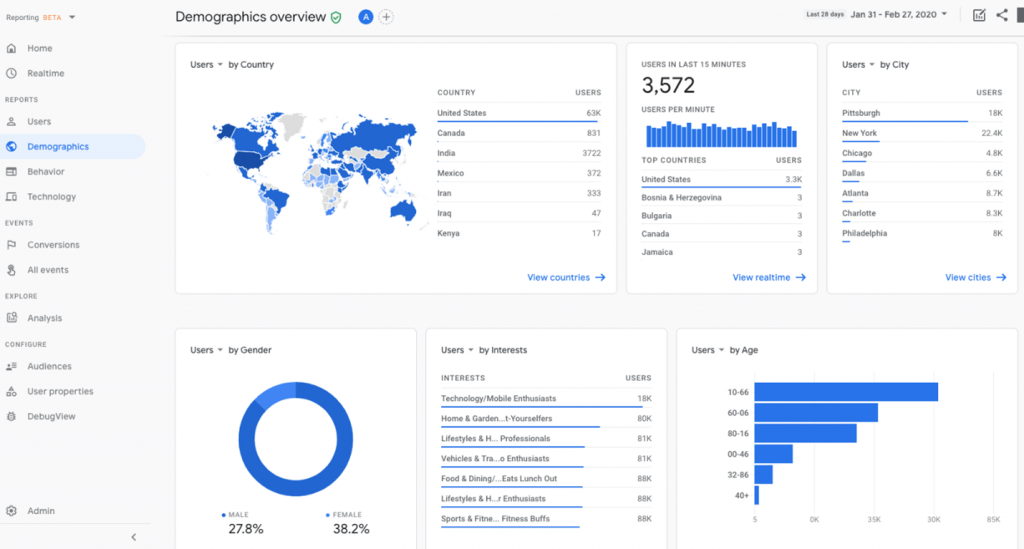If you’re a digital marketer or business owner with an online advertising presence, you’re almost certainly using Google’s Universal Analytics. And it’s probably not news that Google is moving in a new direction to eventually replace Universal Analytics with their new platform, GA4.
We’re here to tell you more about it, and why you should make the switch sooner rather than later.
What is GA4?
GA4 stands for Google Analytics 4 and is Google’s newest analytics service, enabling you to better measure engagement across your site. It can help you get further insights into the customer journey for users interacting with your site and products while also addressing privacy concerns that were arising from the previous Universal Analytics’ methods.
Essentially, you’re able to learn more about what engages your customers while they receive better protection of their data.
While GA4 has been around for a little bit, it will become the default as of July 2023, after which Universal Analytics will be discontinued. Because of this, if you’re not using GA4 already, we highly recommend learning about it now to ease the transition from UA instead of having to do it all at once in the summer of ‘23.
What differentiates GA4 from Google Universal Analytics?
The underlying difference in GA4 is that it uses different measurement models and event tracking.
It focuses more on “events” instead of sessions — what are the critical junctures in between these sessions and what do they tell us? GA4 is more flexible with event parameters; this lets it provide additional information to follow user behavior and interactions, plus auto-event tracks without you needing to create a tagging setup first.
GA4 also gives users more privacy; instead of relying on cookies, it will be able to measure information cookie-free and create models of behavioral and conversion trends.
While custom channel groupings are now gone, default groupings are available and are done programmatically. Similarly, it has, in Google’s words, “predictive capabilities” that will help point you in better directions.
Reports are also changing. While Google UA has built-in reports, GA4 is more geared toward custom reporting. But what exactly is “custom reporting” and what does it mean for you?
For starters — some of you might not love the next few words — it has a new interface. Yeah, we get it, change can be a pain in the butt to adapt to, but you’re not gonna go too far in digital advertising by being a static luddite anyway, so you might as well embrace it. This new interface shows you metrics directly related to both conversions and behaviors that have been deemed most impactful.
The end result is customized reporting that wasn’t available in Google UA and now provides you with more relevant information.
Screenshot of the demographics overview in Google Analytics 4
Why we recommend migrating from Google UA to GA4 now
As we mentioned above, you won’t be able to use UA after July 1st, 2023. After that, you’ll still be able to access data from UA for a few months until December 2023.
Because your historical data will be deleted then, we recommend switching to GA4 ASAP — ideally, you’d have migrated to GA4 by July 1st of 2022 to give you a full year’s runway and year over year data, but of course that’s already come and gone. Still, the sooner you switch to GA4, the sooner you’ll start accumulating data that you’ll have access to after December 2023.
The alternative of switching to GA4 only once you have no choice in July 2023 means that once December 2023 rolls around, you’ll only have a few months’ worth of data to work with.
We further recommend this simply because giving yourself time to adapt will make the process much easier than having to scramble once you don’t have a choice. Not switching over until you’re forced will give you little leeway for adjusting to the system — not only that, but you’ll already be “behind” your competitors who wisely made the change earlier.
While it can be annoying to have to change platforms, GA4 has new features and approaches that benefit both you as a business owner or marketer and the users who interact with you. In our experience, adaptations like this are often an initial pain that doesn’t last too long, followed by a clear improvement that lasts ages. You’ll likely find that it’s sooner rather than later that you come to prefer GA4.





